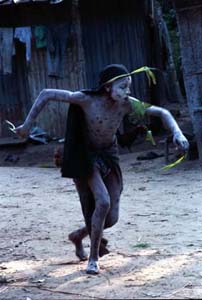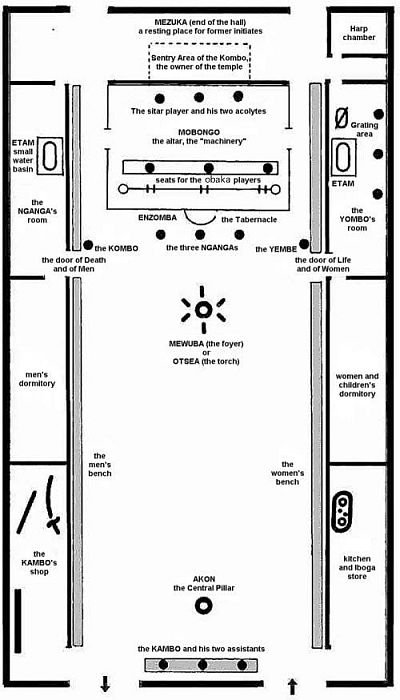The Bwiti & Initiation
The Bwiti is the name given to the religion practised by the Mitsogos and the Fangs, two distinct tribal groups in Gabon.
The Bwiti of the Mitsogos i.e. the original Bwiti, was a product of the fusion of ancestor worship enhanced by the discovery of eboga. The Bwiti of the Fang is a later development in Gabon and is interlaced with many newer influences, such as their memories, their traditions and ideas and rites that came from Catholicism. Unlike the Mitsogo they initiate both men and women. They appear to have come from central Africa fleeing from Islam.

©Photo by Sylvie Le Bomin
Currently, the primitive Bwiti (as it is described by one author) is on the decline while the Bwiti of the Fangs is expanding, though perhaps, according to some, it is losing a little of its initial purity.
In the words of one writer Rene Bureau, ‘Gabon is to Africa what Tibet is to Asia, the spiritual centre of religious initiations’. P. Barabe describes the Fang as being eager to receive that which is new, convinced that they can integrate all techniques and ideas into their own culture. It was therefore just a matter of time before they would take possession of the primitive Bwiti of the Mitsogos and modify it.
Within the Bwiti iboga is used as an aid to concentration and to stimulate recovery from illness. It is used as a sacrament in the ‘Bwiti initiation ritual’, a complex 3-day ‘rebirth’ ceremony that is a required part of membership of the group.
Initiation takes place, usually, between the eight and thirteenth birthday. The overall aim of the ritual is to be emotionally and spiritually reborn, so that the initiate may take their place within the group as a true adult. For this a high level of iboga is consumed with the purpose of relieving the initiate of the effects of any trauma in the psyche via the retrieval of repressed memories within a dreamlike state, as well as to connect them to world of the ancestor’s.
For a detailed study of the use of iboga among the Bwiti see the following anthropological report:
Bwiti: an Ethnography of the Religious Imagination in Africa by James W. Fernandez.
For a number of technical descriptions of an iboga (ibogaine) session as experienced in the West (which generally lasts 36 hours broken down into 3 phases) see: Technical descriptions of an eboga session.
Traditional Use of Eboga by Bwiti
The Bwiti Temple
For those who are interested, a better understanding of the layout of the Bwiti Temple can be found in the following document: The Religion of Eboga or The Bwiti of the Fangs by Barabe, P., Professor.

Please take careful note:
According to Nick Sandberg Westerner’s are not advised to travel to the region to undergo the Bwiti initiation ceremony.
He states:
‘The Bwiti initiation ritual, as this “rebirth” ceremony has come to be known, has in recent years attracted the attention of some Westerners who find themselves romantically drawn to the notion of travelling to the region and undertaking it themselves. Anyone considering doing this should be aware of three things. Firstly, that both the Cameroun and Zaire, two of the three countries where the Bwiti are located, are now regarded as being acutely dangerous for Westerners (Zaire especially). Secondly, that, in Gabon, the remaining country, only the least reputable groups would usually consider initiating Westerners, and then almost certainly only undertake the task for financial gain, likely in a half-hearted fashion. Finally, it should be remembered that each year some local initiates are believed to die during the ceremony, bizarre court cases between parents and priests frequently resulting.’
Initiation in West Africa can be a very difficult experience as it is tied up in local custom which is much tougher than Western practise with few of the conveniences one may be accustomed to. There is also the real and present danger of dyhydration which can lead to death.
